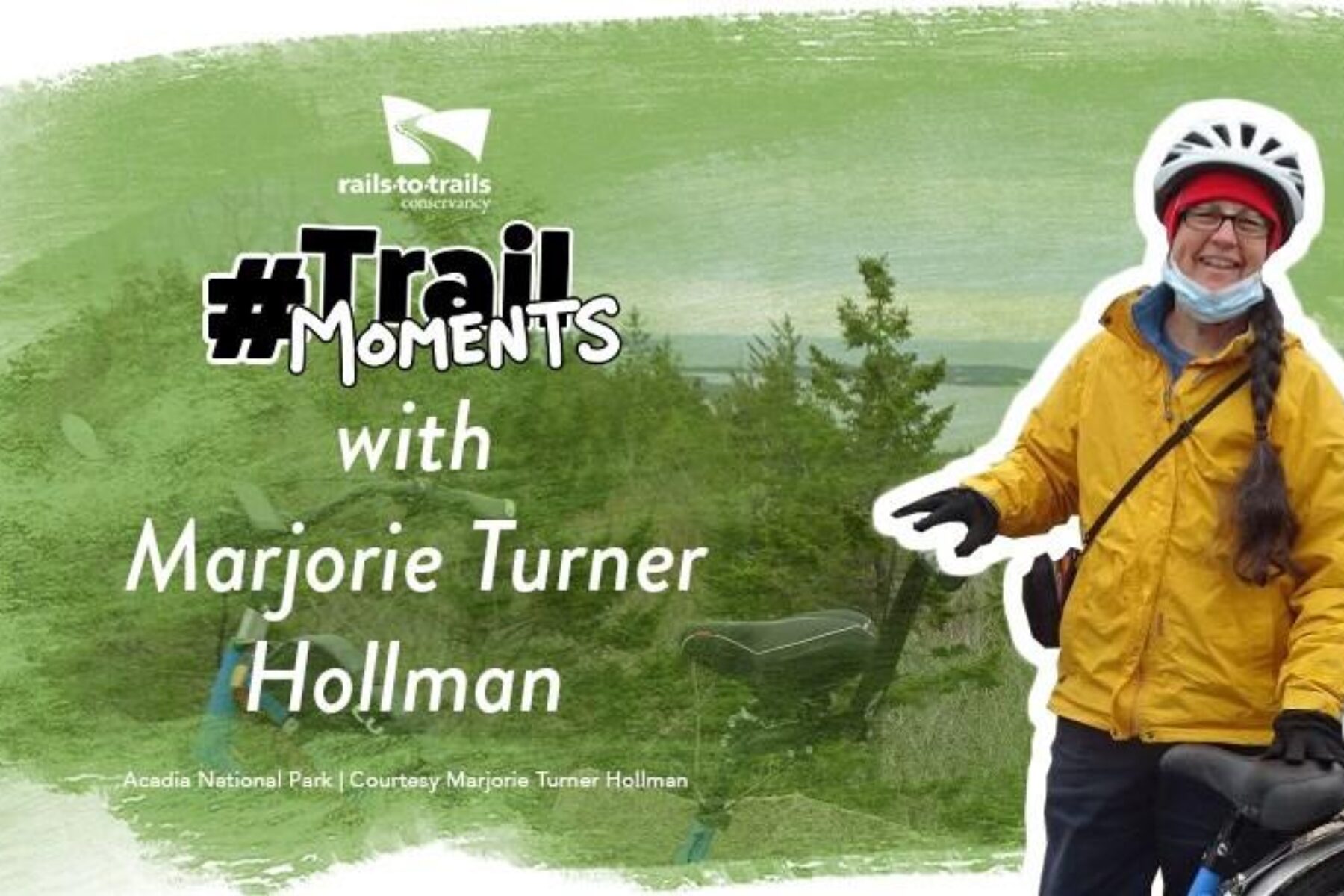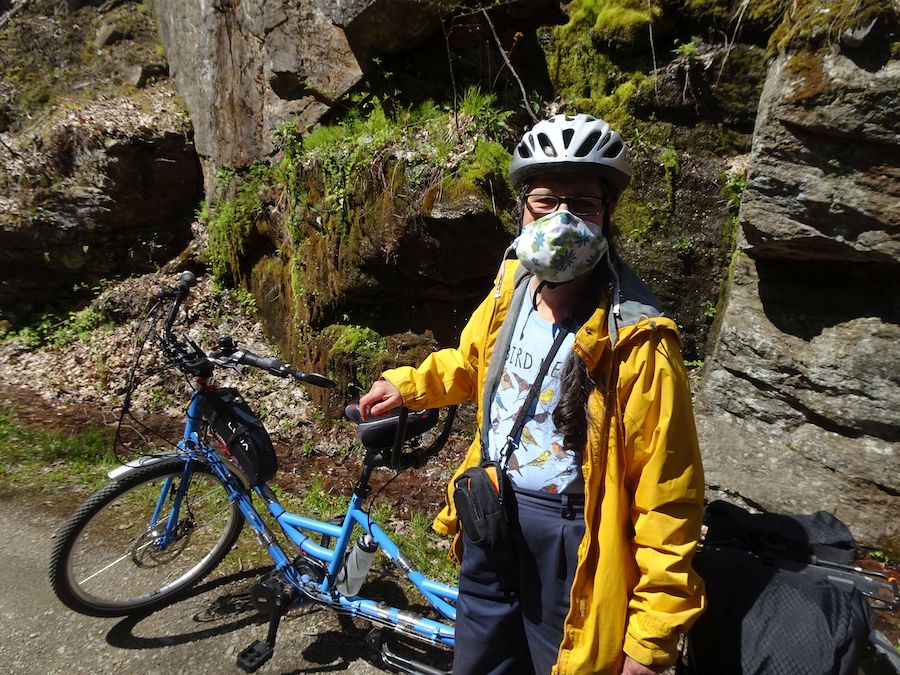Trail Moments | Adapting to the Pandemic: Finding Safe Outdoor Spaces in a Changed World

Our family has visited rail-trails throughout New England and beyond, bringing our adaptive tandem bicycle along so I could explore more than the limited distance I am able to walk (about 2 miles). My right leg and foot are partially paralyzed, so I only take easy walks (not too many roots or rocks, relatively level and with something of interest along the way), using hiking poles to offer support and aid in balance. Nearly 30 years ago, as I lay in a hospital bed with my right side totally paralyzed, I could not imagine that one day I would be writing books about walking. In the intervening years, I have experienced many levels of healing and have written four Easy Walks books.

Finding a tandem bike I could use has been a journey in and of itself, but once we located one I could get on—and stay on—safely, the sky (or at least as far as we were able to drive) has been the limit in exploring rail-trails. Pedaling along on the back of our tandem, I feel like I am flying. What an intoxicating sensation, after feeling so earthbound by the health challenges I have learned to adapt to these past nearly 30 years.
And then, the pandemic. This past year we have all struggled to cope, and keep ourselves safe from the COVID-19 virus. The outdoors became a refuge for many, a place we could feel safer spending time with family and friends. And yet, this reality meant that the most visible trails (especially well-marked rail-trails!) near where we live became overcrowded. Parking lots were jammed, and people unfamiliar with “rules of the road” were unaware of the challenges of combining bikes, kids and adults with dogs on leashes, all in relatively narrow pathways.

Part of the Southern New England Trunkline Trail is so close to our home that we can easily walk (or bike) to get on finished portions of the 22-mile trail, much of which is still being developed. Massachusetts’ Upper Charles Trail in Milford and Holliston has some stunning architectural structures—the eight-arch bridge and the Phipps tunnel—as well as some lovely views near the headwaters of the Charles River. Although the Blackstone River Greenway connecting Massachusetts and Rhode Island is not yet fully connected, it’s part of a planned, nearly 50-mile stretch of rail-trail that, when finished, will follow the Blackstone River from its headwaters in Worcester to where it reaches Slater Mill in Pawtucket, Rhode Island, the birthplace of the American Industrial Revolution. We are so lucky to have access points for all these trails less than a 20-minute drive from where we live in Bellingham, Massachusetts (30 miles south of Boston). And yet, we wanted to avoid people, and these special places suddenly had the feel of crowded urban cities. What to do?

We mostly took a sabbatical from using rail-trails and explored how it felt to try road biking. Pre-pandemic, we had avoided riding on local roads, concerned the mix of bikes and vehicles was unsafe. But in the early days of COVID-19, local roads were nearly empty. We explored roadways near our house that we had never felt safe riding our tandem on. We met no one on the public roads—others were hunkered down in their homes, or out on our local rail-trails!
Related: Closing Streets to Create Space for Walking and Biking
We got bright orange safety triangles for the back of our bike, wore our reflective vests, brought along flashing lights and a small flag, and headed to country roads that might offer river views and other points of interest. We tried riding on some more remote rail-trails, but always had a Plan B in hand, checking maps to make sure we had country roads we were able to access if needed. We pedaled along nearly deserted roads. We stumbled upon quiet wildlife sanctuaries that we explored on foot. We rode atop Army-Corps-of-Engineers dams that had few visitors, and we found roads not far from the Rhode Island shore with small historical cemeteries next to the road.
We kept checking to see if we could visit our local rail-trails but, up through the fall of 2020, rail-trail parking lots were still full. I have an Easy Walks Facebook group where people kept asking what they could do to get out safely during the pandemic. I offered the same strategies detailed in my books: Get out early, walk near the end of the day (and bring a headlamp), take a walk in the rain—it’s what raincoats are for! I suggested they look for local town-owned open-space properties with less well-known trails. At times it felt like this way of life might never change.

We took one trip to Maine to enjoy the carriage roads of Acadia National Park. Although these carriage roads are not rail-trails, they offer 48 miles of spectacular gravel paths throughout the park. The carriage roads on the island portion of the park were so crowded that we headed over to the less-visited Schoodic Peninsula section of the park and found it nearly empty. There, we pedaled to our hearts’ content along the carriage roads, and then followed the one-way road along the shoreline, taking in stunning views of Acadia National Park across Frenchmen’s Bay on Mt. Desert Island.

With the introduction and distribution of vaccines, our community has now removed restrictions, marking the return of businesses and life as we knew it. As I suspected, many of those who spent so much time on our local rail-trails have now returned to other activities, but some have learned that they really enjoy getting outdoors and are hooked. As for me and my family? We have returned to our beloved rail-trails. Walking, pedaling, visiting familiar trails and looking for new ones to explore.
Related: A View From… New England’s Rail-Trail Network
This article is part of Rails-to-Trails Conservancy’s Trail Moments initiative—to elevate new and tried-and-true trail voices around the country, and how trails impact the lives of Americans. Learn more at trailmoments.org and #TrailMoments on social media. Share your story, or view a collection of trail moments stories.

Donate
Everyone deserves access to safe ways to walk, bike, and be active outdoors.
